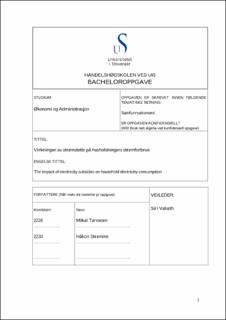| dc.contributor.advisor | Valseth, Siri | |
| dc.contributor.author | Tønnesen, Mikal | |
| dc.contributor.author | Strømme, Håkon | |
| dc.date.accessioned | 2023-07-11T15:51:40Z | |
| dc.date.available | 2023-07-11T15:51:40Z | |
| dc.date.issued | 2023 | |
| dc.identifier | no.uis:inspera:145995936:21048363 | |
| dc.identifier.uri | https://hdl.handle.net/11250/3077655 | |
| dc.description.abstract | Formålet med oppgaven var å undersøke endringer i husholdningers strømforbruk i lys av strømstøtten i Sørvest-Norge. Regjeringen (2021) presenterte en midlertidig ordning som skulle hjelpe vanlige folk i hele landet med håndteringen av de rekordhøye strømprisene gjennom vinteren. Ordningen ble forlenget og nivået på støtte økte, først i januar 2022, og senere i oktober 2022. Ved å anvende regresjonsanalyser, undersøkte vi sammenhengen mellom strømforbruk, temperatur, strømpris og strømstøtte. Vi utførte analyser for både hele støtteperioden, i tillegg til periodene med forskjellige nivåer. Resultatene fra analysene viser hovedsakelig en reduksjon i strømforbruket i perioden med aktiv strømstøtte, men det er usikkert om strømstøtten er årsaken til dette. Det kan muligens forklares ved at selv om støtten reduserer strømkostnadene til husholdningene, vil strømprisen inkludert strømstøtte fremdeles være høyere enn hva den var før støtten ble innført. Tidligere studier viser også at økt oppmerksomhet rundt økonomiske fordeler ved energisparing fører til at husholdninger reduserer sitt forbruk. Videre fant vi ut at temperaturen har større påvirkning på forbruket enn strømprisen. Det er derfor utfordrende å fastslå hvordan strømforbruket har blitt påvirket av innføringen av strømstøtte. Samlet sett indikerer studien hvordan og hvorfor strømforbruket har endret seg i perioden med økte strømpriser, både inkludert og ekskludert strømstøtte. | |
| dc.description.abstract | The purpose of the study was to investigate changes in household electricity consumption in light of the electricity subsidy in Southwest Norway. Regjeringen (2021) presented a temporary scheme to help ordinary people across the country cope with the record high electricity prices during the winter. The scheme was extended and the level of support increased, first in January 2022, and later in October 2022. By applying regression analyses, we examined the relationship between electricity consumption, temperature, electricity price, and electricity subsidy. We performed analyses for both the entire support period, as well as periods with different levels. The results from the analyses mainly show a reduction in electricity consumption during the period with active electricity support, but it is uncertain whether the electricity subsidy is the cause of this. It may possibly be explained by the fact that even though the support reduces the electricity costs for households, the electricity price including the subsidy would still be higher than it was before the support was introduced. Previous studies also show that increased attention to the economic benefits of energy saving leads to households reducing their consumption. Furthermore, we found that temperature has a greater impact on consumption than the electricity price. It is therefore challenging to determine how electricity consumption has been affected by the introduction of electricity support. Overall, the study indicates how and why electricity consumption has changed during the period of increased electricity prices, both including and excluding electricity support. | |
| dc.language | nob | |
| dc.publisher | uis | |
| dc.title | Virkningen av strømstøtte på husholdningers strømforbruk | |
| dc.type | Bachelor thesis | |
